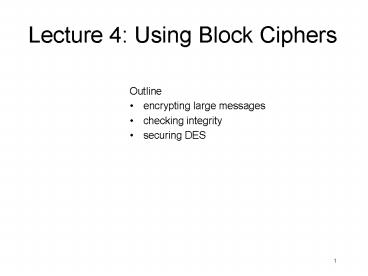Lecture 4: Using Block Ciphers - PowerPoint PPT Presentation
1 / 16
Title:
Lecture 4: Using Block Ciphers
Description:
Electronic Code Book (ECB) How to use a block cipher to encrypt a large message? M2 ... padi=e(padi-1,key) k-bit shifting (see pic) advantages ... – PowerPoint PPT presentation
Number of Views:109
Avg rating:3.0/5.0
Title: Lecture 4: Using Block Ciphers
1
Lecture 4 Using Block Ciphers
- Outline
- encrypting large messages
- checking integrity
- securing DES
2
Electronic Code Book (ECB)
- How to use a block cipher to encrypt a large
message?
break message into blocks
encrypt eachblock separately with secret key
3
Problems with ECB
- same plaintext block produces same ciphertext
- can be analyzed, rearranged
plaintext
ECB encrypted ciphertext
4
One-Time Pad
- proven (Shannon) XOR a message with a (truly)
random number (never reuse it again)
unbreakable (no information is given away) - one-time pad such usage of random numbers
- stream cipher generates one-time pad and XORs
it with the stream of plaintext to generate
ciphertext
5
Fixing ECB
- consider this generate random numbers and XOR
with blocks before encoding
M1
M2
M3
M4
transmit r1, c1, r2, c2, r3, c3, r4, c4
r1
r2
r3
r4
E
E
E
E
C1
C2
C3
C4
- problems
- need to send twice as much data
- can still rearrange blocks
- if two ciphertext blocks equal, know XOR of two
plaintext blocks XOR of the corresponding two
random numbers
6
Cipher Block Chaining (CBC)
- randomizes output by using previous ciphertext
block - first block is randomized using initialization
vector (IV)
IV
M1
M2
M3
M4
E
E
E
E
IV
C1
C2
C3
C4
- how does CBC do decoding?
7
CBC Decryption Analysis
IV
C1
C2
C3
C4
D
D
D
D
IV
M1
M2
M3
M4
- What happens if Ci gets lost or garbled? How
much data gets lost? - assume an attacker knows block Mi and wants to
change it, what does it need to change? - can encryption/decryption be done in parallel?
8
Output Feedback (OFB) Mode
- OFB is a stream cipher
- IV based, IV is transmitted in clear
- two versions
- no shifting
- pad1e(IV, key)
- pad2e(pad1, key)
- padie(padi-1,key)
- k-bit shifting (see pic)
- advantages
- the pad can be pre-generated no costly
operations at run-time (good for multimedia or
resource-constrained devices) - how much info is affected if portion of
ciphertext is garbled/lost? - problems
- if known plaintext, can be altered
- is random access possible?
- can encryption/decryption be done in parallel?
k-bit shifting version of OFB
9
Cipher Feedback (CFB) Mode
- similar to OFB
- message data is alsoused to generatepadding
- advantages
- is random access possible?
- what if part of ciphertext is garbled/lost/duplica
ted? - problems
- is OFB-like pad pre-generation possible?
- can it be altered if plaintext is known
- can encryption/decryption be done in parallel?
10
Counter (CTR) Mode
- CTR is another stream cipher
- to create pad, IV is incrementedand encrypted
- is random access possible?
- what if part of ciphertext is garbled/lost/duplica
ted? - is pad pre-generation possible
- can encryption/decryption be done in parallel?
- is known plaintext alteration possible?
11
Integrity checking
- automated integrity checking computer should be
able to detect tampering (a human presence should
not be required any garbage can pass through) - message authentication code (MAC) a
cryptographic checksum generated with the help of
a key - CBC, OFB, CFB and CTR good security, integrity
vulnerable
12
CBC Residue
- Do CBC encryption on M using key K, throw away
all but last block. - send message in clear the residue,
- Used in banking
- Has property that if you dont know the key you
cant generate (or verify) the MAC, or modify the
message without (probably) changing the MAC - however, can generate an arbitrary message
matching MAC
13
Joint Privacy and Integrity
- concurrently use two CBCs one for privacy, the
other for integrity - why cant use only one for both?
14
Securing DES
- purpose retain the same mechanism, expand key
size - why not double DES?
- encrypt with K1 twice. How much more work (over
DES) for good guys? Bad guys? - encrypt with K1 then K2. What is time/memory for
bad guys? Good guys? - subject to subtle known plaintext attack
15
3DES
- Defined as doing EDE with K1, K2, K3, but
standardly K1 is set equal to K3. - reason because of known-plaintext attack, 3DES
is considered to only have time-strength equal to
112 bit key, not 168. - also, 112 bits considered enough (for now).
- why EDE instead of EEE?
- Initial and final permutations would cancel each
other out with EEE (minor advantage to EDE) - EDE compatible with single DES if K1K2K3.
16
3DES and CBC
- CBC is defined to be done on the outside of 3DES
- same integrity problems as with regular CBC
- CBC can potentially be done on the inside of 3DES
- more secure against tampering
- but
- more work
- garbling/loosing/duplicating of one block garbles
the rest of message































